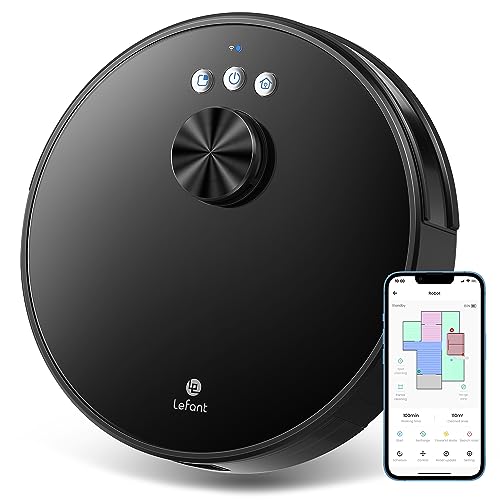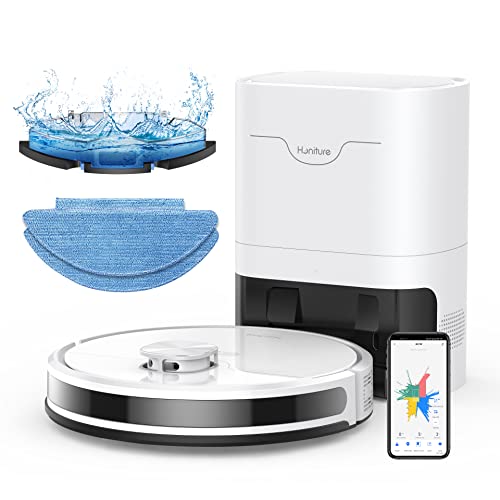9 . What Your Parents Teach You About Lidar Vacuum Mop
페이지 정보
작성자 Luca Alvarez 작성일24-08-03 19:50 조회45회 댓글0건관련링크
본문
 LiDAR Vacuum Mop
LiDAR Vacuum MopThis robot vacuums and mops by using Light Detection And Ranging (lidar). This makes it more efficient than earlier technology and helps prevent hitting objects while cleaning.
 The model creates an image of your floor and can detect any obstacles, even small ones such as socks and charging cables. You can also create virtual boundaries and no go zones in the ECOVACS App for customized cleaning.
The model creates an image of your floor and can detect any obstacles, even small ones such as socks and charging cables. You can also create virtual boundaries and no go zones in the ECOVACS App for customized cleaning.LiDAR Technology
LiDAR is a remote sensing active technology that uses lasers to measure objects on the ground. The laser light is fired and reflected by objects such as trees or structures. By measuring the amount of time it takes for the laser light reflected to return to the sensor, the distance of these objects can be determined. LiDAR is used by robot vacuum cleaners in order to allow them to see a greater area than they would without it. This helps them avoid obstacles more effectively and plan their cleaning routes more effectively.
An excellent example of how LiDAR technology can be incorporated into robot vacuum cleaners is the Neato XV11. In this model, a rotary laser is integrated into the lidar sensor in order to detect the floor and to identify objects that might block its path. This information is then utilized by the SLAM algorithm to make more precise maps of the space and design routes that take into account obstacles. This leads to a more thorough and efficient cleaning.
The Neato XV11 has anti-drop sensors as a bonus. These help keep it from falling off furniture or falling over steps. It also recognizes when it's in a carpeted area and automatically increases suction power to 2000 Pa. This allows the vacuum to perform more efficiently and reduce wear to your carpet.
Many kinds of industrial applications rely on LiDAR technology for creating 3D models as well as quality control requirements. lidar robot vacuum technology can be utilized to create digital elevation models that can be useful for engineering projects and infrastructure maps. The data can be used to determine the safety of a site, including identifying hazards like flood zones and landslides.
LiDAR sensors are also used by meteorologists and researchers to measure a variety of atmospheric components. These include cloud cover, temperature, wind speed and air density. This type of information is essential to forecast the weather and provides vital information to utilities and energy companies.
SLAM Technology
SLAM, or simultaneous localization and map, is a method that helps robots to map their environment while tracking their location within that space. The concept behind SLAM was the subject of decades of computer and mathematical research. However, it is now more practical due to the increasing computing power and decreasing costs of the various components of the robot system. One typical example of a device based on SLAM is the robotic vacuum cleaner.
A SLAM vacuum cleaner makes a map of the room that it is cleaning. This allows it to move more efficiently and avoid obstacles. The method used to achieve this is through a combination of sensors and algorithms including visual (or vSLAM) scanning and a laser rangefinder. These sensors detect surfaces of objects, like a table or sofa and utilize this information to create an imaginary map of space.
After the vSLAM mapping process is completed it can determine a route to follow. It can determine how to avoid obstacles such as chairs or tables and still be in a position to reach all the corners and other parts of a room. Utilizing a laser rangefinder the robot can also determine its distance from objects as well as other features of a room.
Gyroscopes are a different sensor that is used in some robot vacuums to assist them avoid bumping into things and create a basic map of their surroundings. While they aren't as precise as systems using LiDAR or SLAM but they are an adequate navigation solution for a variety of robot vacuums and can be incorporated into cheaper models.
If you are looking for a more sophisticated robotic vacuum mop, look for one that has sensors in combination with SLAM technology. For instance, the DEEBOT X1 OMNI from ECOVACS uses vSLAM and a YIKO voice assistant that allow you to operate it hands-free. It will empty its trash bin automatically and refill water, and its OZMO Turbo pressurized mop has a maximum suction of 5,000Pa to provide a strong clean. It's compatible with iOS, Android and Google Assistant.
Gyroscopes
The sensors known as gyroscopes aid robots in avoiding bumps against objects, and can even create an initial map. They're a great method to ensure that your robot cleaner is able to maneuver around furniture and other obstacles in the room. However, if you're searching for the best mapping technology in your next mop or vacuum make sure you choose one that makes use of LiDAR.
LiDAR (light detection range) technology emits a pulse of laser light into space and measures the time it takes for the pulse to return from the object. This information is used by the robot to create an imaginary 3D map of the area. It also allows it to recognize objects and design efficient cleaning routes.
This technology is extremely beneficial, and allows the robot to maneuver through even the most complex spaces, like rooms with multiple levels or stairs. It's also much more efficient than mapping systems that rely on cameras. And unlike camera-based mapping, which requires lights to work lidar can be used in the night and in darker areas.
Many gyro-navigation robots have features that allow you to schedule cleaning sessions and track the progress of your cleaning sessions through the app. This means that you can leave your home at the beginning of the day and be assured that it will be spotless when you get back. This feature is great for those with a busy schedule or who are away from home often.
ECOVACS DEEBOT vacuum and mop robotics utilize LiDAR technology to provide a thorough cleaning. The newest DEEBOT X1 Omni is a follow-up to. This model provides a completely hands-free experience due to its all-in-one OMNI station. It will automatically empty the trash bin, refill water and separate clean water from dirty mop heads. It can also dry the mop's head quickly with hot air, and prepare it for the next cleaning session.
This newest model also features OZMO Turbo 2.0 which rotates the mop up to 180 times per minute to provide premium scrubbing capability. It can also automatically change to auto-boost for carpet when it detects it's moving from hard floors to carpet for a more powerful clean.
Sensors
Lidar sensors, which are similar to gyroscopes help robots avoid bumping against objects and provide basic maps of a room. These systems are more complicated than gyroscopes, and provide more precise information about the environment.
Lidar technology, which stands for Light Detection and Ranging, utilizes a rotating laser which sends out a pulse of energy that bounces off surrounding surfaces and then reflects back to the sensor. The sensor converts the distance into accurate measurements by analyzing the amount of time taken for each reflection. This information is used to create a 3D map of the room, helping the robot identify obstacles and navigate more efficiently.
Unlike traditional navigation systems, which use visual data to locate and navigate the surroundings robot vacuums equipped with lidar are able of recognizing and navigating through all kinds of different objects. This helps to reduce the risk of collisions and lets users enjoy a completely hands-free cleaning experience.
Lidar sensors can face issues, too, like other sensors in robotic vacuums. This includes interference from reflective surfaces and complex room layouts. In these instances it is possible to clear the area of any obstructions to improve the efficiency of the system. Cleaning the sensor and keeping it free from dust or debris can also aid in improving the performance of lidar mapping.
A robotic vacuum that is equipped with lidar is also enhanced by its ability to move through furniture and recognize it. This technology is especially useful in larger spaces and can prevent the robot from wandering around the room, or getting stuck in corners. This is a major benefit for busy homeowners and gives them the peace of mind that their home is being thoroughly cleaned without having to oversee the process.
ECOVACS offers a range of high-end robotic vacuums including the DEEBOT X1 Omni. This all-in-one device can separate clean water from sewage and refill the mop head. It also has a integrated YIKO voice assistant to provide a hands-free experience. The new omnidirectional motor spins at up to 180 times per minute and delivers powerful suction of up to 6,000Pa. This makes it perfect for large homes or commercial environments.
댓글목록
등록된 댓글이 없습니다.
